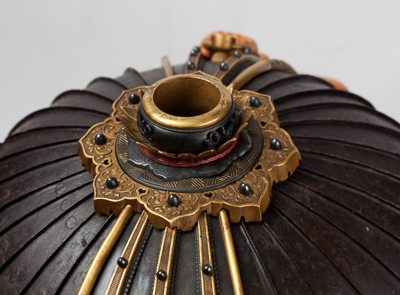Why is there a hole on the helmet?
16 July 2018
On the great majority of Japanese helmets there is a hole, more or less large, that can leave puzzled those who do not know its origins. Why should a samurai have a hole on the most important part of the armor? Here are some considerations on the origin and use of the tehen.

- It is thought that in the medieval times the samurai passed his hair through the tehen in order to keep the kabuto firmly on the head. The hairstyle called chonmage in fact features a shaved pate, while the remaining hair were left long and tied to form a small ponytail that folded over the top of the head.
- In a kabuto with lamellar construction, obtained by riveting several (up to 120!) plates side by side, it would not be possible to join all the lamellas in the center: leaving a central hole allowed to have only a few plates overlapped and not all of them in one place.
- The samurai believed that through the tehen the spirit of Hachiman, the god of war, could pass into them. For this reason this hole on the kabuto is sometime sometimes colled hachiman-za, literally "the seat of Hachiman".
- In the armor of the Edo period, the tehen was richly adorned with multi-layered decorations, sometimes made of various metals. There are some schools of armorers where the tehen was so well finished and precise that it was covered only with a small iron rim, and sometimes not even with that. In the latter case it is possible to appreciate the value of the kabuto and admire the mastery of those who made it.
Copyright © 2016 - giuseppe piva - VAT: 05104180962

